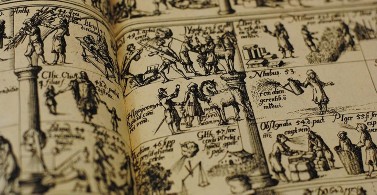| ||||||||||||||||||||||||||||||||||||||||||||||||
|
|
| |||||||||||||||||||||||||||||||||||||||||||||||
|
Unit 1 History of the LawUNIT 1
History of the Law
Since the time when people first began living together, rules have been adopted to protect individuals and groups and to govern their relationships. Even the most ancient peoples compiled Law codes. A law code is a more or less systematic and comprehensive written statement of laws. The oldest law code is tablets from the ancient archives of the city of Ebla (now Tell Mardikh, Syria), which dates to about 2400 BC.
The earliest written law was also the Law Code of Hammurabi, a king who reigned over Babylon (on the territory of modern Iraq) around 2000 B.C.
Hammurabi’s Code had 282 paragraphs and was carved in cuneiform on a pillar made of very hard stone. This pillar was set up in a temple to the Babylonian god Marduk so that everyone could read it.
After the fall of Babylon in the 16th century B.C. the pillar was lost for centuries. It was found again during archeological expedition among the ruins of the Persian city of Susa in 1901. Now the pillar is in Paris in the Louvre museum.
The scientists managed to read Hammurabi’s Code. It dealt with many of the same subjects as our legal system today. It included real and personal property law (the rights of slave owners and slaves, inheritance and property contracts), family law (divorce and marriage), criminal law (crimes and punishment of crimes), and business law (settlement of debts and even regulations about taxes and the prices of goods). The Code gave very harsh punishments for almost all crimes. Not only murderers but also thieves and those guilty of false accusation faced the death penalty. The punishment was based on the principle of revenge: an eye for an eye and a tooth for a tooth. The criminals had to receive the same injuries and damages they had inflicted upon their victims.
Nevertheless, the penalty according to Hammurabi’s laws could not be harder than the crime. The code banned the tradition of kidnapping women as brides. The laws of Hammurabi’s Code took into account the circumstances of the offender as well as the offence itself. For example, if a citizen of a lower rank lost in a civil case he had to pay fewer penalties than an aristocrat, though if he won he also was awarded less.
The laws set forth in Hammurabi’s Code were written by the King - a divinely inspired authority. Only the King could change such laws. This absolutism of power in the monarch was typical of legal systems until the time of the Greeks around 300 B.C.
A
Task 1. Give the English for: уголовное право, семейное право, развод, гражданское право, имущественное право, право, смертная казнь, вор, преступник, обстоятельства правонарушителя, штраф.
Task 2. Match English and Russian equivalents:
Task 3. Find the words with similar meaning among the following: to prohibit, conviction, punishment, to deal with, penalty, offense, harsh, to concern, crime, offender, strict, criminal, to ban, accusation.
Task 4. Answer the following questions:
B Task 1. Make the summary and annotation of the text:
How did the British Law Develop?
In early medieval England, there was no written law. Each feudal lord or baron administered justice personally. Although these baronial courts had similarities, the laws were different in different places. Disputes were settled on the basis of local customs and the baron’s judgment. In time, the king was able to establish a system of courts, which enforced a common law throughout England. The rules of law, which were stated in these early cases, became precedents (examples) for settling future, similar cases. In the beginning, few decisions were recorded, and so the early common law was sometimes known as “unwritten law.” Finally, the principles and rules announced by the courts were preserved in writing. Thus, particular rules became fixed, and people knew what to expect if similar problems arose in the future. This resulted in what has come to be known as the Common Law - judge-made case law that has its origin in the traditions, customs, and trade practices of the people.
The English common law began to develop after the conquest of England by William the Conqueror in 1066. To keep order and peace, the Kings of England tried to create a uniform or «common» law to govern the different regions of the British Isles. Circuit-riding judges (выездная сессия суда) and the use of the jury aided the Norman Kings in the consolidation of their kingdom. In medieval England, sometimes there was no remedy available from a common law court to enforce certain rights or to correct certain wrongs. This was because in civil cases the court could give only monetary damages. A person who wanted any other kind of relief would appeal directly to the king. The king would refer the person to his chancellor, who was usually a clergyman of good conscience and fairness. The chancellor would hear the case without a jury and would then give appropriate relief. Such hearings developed into what came to be known as a separate system of Courts of Equity.
Task 2. Read and translate the text: The Magna Carta
In 1215, the English barons forced the English King John I to sign and adopt the Magna Carta, which provided for them certain guarantees and protection against unreasonable acts of the king. Later, the Magna Carta was revised, and other documents, such as the English Bill of Rights (1689), were adopted.
When the thirteen American colonies broke away from Great Britain after the Revolutionary War, the colonists adopted the principles of the Magna Carta and the Common law. These principles became the foundation of the legal system of US federal government and of all the states.
Today, the two great systems of law in the Western world are the Common law of the English-speaking world and the Roman civil law found on the continent of Europe. Both systems have the same objectives, but they differ in origins and methods. The Roman civil law originated in codes (systematic collections of written rules of law) imposed on the people by the emperors of ancient Rome. In contrast, the English common law originated in decisions of judges based on widely held customs of the people. Also, English common law uniquely provides for trial by a jury of one's peers (equals).
The English colonies in America recognized the English common law as governing until July 4, 1776. After that date, existing rules were retained, but further changes in the law were made in the courts of the newly formed American country. The Common Law, with its emphasis on judges making rules of law, continues to serve well till now.
1) Match the following:
2) Answer the questions:
Task 3. Read and translate the text: Natural Law
Natural law in philosophy is a system of right or justice held to be common to all humankind and derived from nature rather than from the rules of society, or positive law. Throughout the history of the concept, there have been disagreements over the meaning of natural law and over its relation to positive law.
Aristotle held that what was "just by nature" was not always the same as what was "just by law"; that there was a natural justice valid everywhere with the same force and "not existing by people’s thinking this or that"; and that appeal could be made to it from the positive law. He drew his instances of the natural law, however, chiefly from his observation of the Greeks in their city-states, with their subordination of women to men, of slaves to citizens, and of barbarians to Hellenes. The Stoics, on the other hand, conceived an entirely egalitarian law of nature in conformity with the "right reason, "or Logos, inherent in the human mind.
Some scholastic philosophers, for instance John Duns Scotus, William of Ockham, and, especially, Francisco Suarez, emphasized the divine will instead of the divine reason as the source of law. This "voluntarism" influenced the Roman Catholic jurisprudence of the Counter-Reformation.
The epoch-making appeal of Hugo Grotius to the natural law belongs to the history of jurisprudence. Grotius insisted on the validity of the natural law "even if we were to suppose . . . that God does not exist or is not concerned with human affairs."A few years later Thomas Hobbes was arguing not from the "state of innocence" in which man had lived in the biblical Eden but from a savage "state of nature" in which men, free and equal in rights, were each one at solitary war with every other. After discerning the right of nature (jus naturale) to be "the liberty each man hath to use his own power for the preservation of his own nature, that is to say, of life," Hobbes defines a law of nature (lex naturalis) as "a precept of general rule found out by reason, by which a man is forbidden to do that which is destructive of his life" and then enumerates the elementary rules on which peace and society can be established. Grotius and Hobbes thus stand together at the head of that "school of natural law" which, in accordance with the tendencies of the Enlightenment, tried to construct a whole edifice of law by rational deduction from a fictitious "state of nature" followed by a social contract. In England, John Locke departed from Hobbesian pessimism to the extent of describing the state of nature as a state of society, with free and equal men already observing the natural law. In France, where Montesquieu had argued that natural laws were presocial and were superior to those of religion and of the state, Jean-Jacques Rousseau postulated a savage who was virtuous in isolation and actuated by two principles "prior to reason", self-preservation and compassion (innate repugnance against the sufferings of others).
The Declaration of Independence of the United States refers only briefly to "the Laws of Nature". The French Declaration of the Rights of Man and of the Citizen asserts liberty, property, security, and resistance to oppression as "imprescriptible natural rights."The philosophy of Immanuel Kant renounced the attempt to know nature as it really is, yet allowed the practical or moral reason to deduce a valid system of right with its own purely formal framework; and Kantian formalism contributed to the 20th-century revival of naturalistic jurisprudence.
1) Answer the questions:
C
| ||||||||||||||||||||||||||||||||||||||||||||||||
|
| ||||||||||||||||||||||||||||||||||||||||||||||||
| © Академия Министерства внутренних дел Республики Беларусь Электронный учебно-методический комплекс | ||||||||||||||||||||||||||||||||||||||||||||||||

